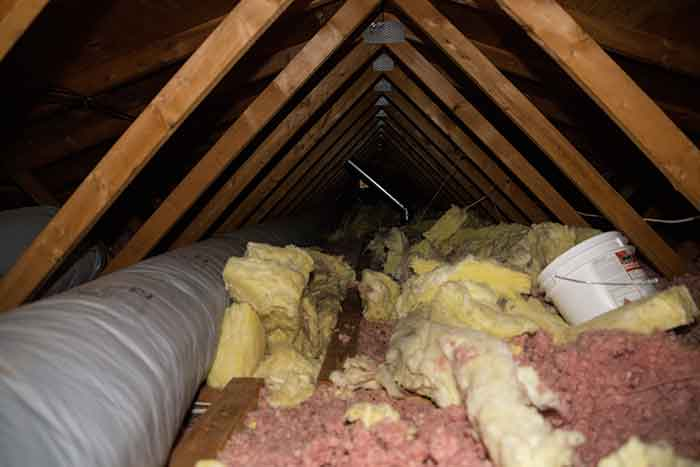Can Old Insulation Be Harmful to Health

Insulation plays a vital role in keeping homes energy-efficient and comfortable by regulating indoor temperatures and reducing energy costs. Historically, a variety of materials were used for insulation, each with its own set of benefits and drawbacks.
However, as these materials age, they may pose health risks that homeowners need to be aware of. Old insulation can harbor hazards such as asbestos, formaldehyde, and other harmful substances that may lead to serious health issues.
This blog post will explore the types of old insulation, the potential health risks they pose, and why addressing these concerns is crucial for maintaining a safe and healthy living environment.
Types of Old Insulation
There are several types of old insulation that homeowners may encounter in their homes. These include:
- Asbestos: Asbestos was commonly used as an insulating material until the late 1970s when it was discovered to be a carcinogen. Asbestos fibers can become airborne if disturbed, and when inhaled, they can cause serious lung diseases such as mesothelioma and lung cancer.
- Formaldehyde: This chemical is often found in older homes as it was widely used in insulation products before the 1980s. Exposure to formaldehyde can irritate the eyes, throat, and respiratory system.
- Vermiculite: Vermiculite was commonly used as insulation in attics and walls from the 1920s to the 1990s. However, it may contain asbestos fibers, making it a potential health hazard if disturbed.
- Urea-formaldehyde foam (UFFI): This type of insulation was popular in the 1970s but was found to emit high levels of formaldehyde gas, causing health concerns for homeowners.
These are just a few examples of old insulation materials that may pose health risks. It's essential to identify and address any potential hazards in your home, especially if you live in an older house.
Can Old Insulation Be Harmful to Health?
Yes, old insulation can be harmful to health. As mentioned earlier, certain types of old insulation may contain hazardous materials such as asbestos and formaldehyde. These substances can cause serious health issues when inhaled or ingested.
In addition to the specific risks associated with each type of insulation, aging materials can also deteriorate over time, releasing particles and fibers into the air. This is especially concerning for those with respiratory conditions or allergies, as these particles can aggravate their symptoms and potentially worsen their health.
Furthermore, if you are planning to renovate your home or make any changes that involve disturbing the insulation, you may unknowingly expose yourself and others to these harmful substances. It's crucial to take precautions and address any potential hazards before starting any home improvement projects.
What Are the Signs That Insulation May Be Deteriorating
While some types of insulation may deteriorate quicker than others, all materials will eventually break down over time. Here are a few signs that your old insulation may be deteriorating and potentially harmful to your health:
- Visible damage: Cracks, holes, or crumbling in the insulation can indicate that it is breaking down and releasing particles into the air.
- Water damage: Moisture can cause insulation to compress, become discolored, or even grow mold. These conditions not only affect the effectiveness of the insulation but can also create a breeding ground for bacteria and other harmful substances.
- Strange odor: If you notice a musty or unpleasant smell coming from your attic or walls, it could be a sign of deteriorating insulation.
- Increased energy bills: If your energy bills have been steadily increasing, it could be a sign that your insulation is no longer functioning properly due to age and deterioration.
Old insulation that shows signs of damage or wear should be inspected and potentially replaced to maintain a safe and healthy living environment.
Steps Homeowners Can Take to Address Insulation Issues
If you are concerned about the potential health risks of old insulation in your home, there are steps that you can take to address these issues. Here are a few suggestions:
Get an inspection:
If you live in an older home or suspect that your insulation may be deteriorating, it's essential to get a professional inspection. A trained inspector can identify any potential hazards and recommend the best course of action.
Consider replacement:
In some cases, old insulation may need to be completely removed and replaced with new, safer materials. This can be a costly endeavor, but it's crucial for maintaining a healthy living environment.
Encapsulate or seal the insulation:
In some cases, encapsulation or sealing may be an option to contain and prevent any potential hazards from being released into the air. However, this should only be done by a professional and may not be suitable for all types of insulation.
Take precautions when disturbing insulation:
If you are planning to renovate your home or make any changes that involve disturbing the insulation, make sure to take appropriate precautions such as wearing protective gear and following proper removal procedures.
Stay informed:
Educate yourself about the potential hazards of old insulation and regularly check for any signs of deterioration. By staying informed, you can take action to address any issues before they become a more significant concern.
Taking these steps can help ensure the safety and health of you and your family when it comes to old insulation in your home.
Tips for Maintaining a Healthy Living Environment
In addition to addressing any potential insulation issues, here are some general tips for maintaining a healthy living environment:
- Regular cleaning: Regularly clean and dust your home to remove any particles or allergens that may be present.
- Monitor humidity levels: High humidity can contribute to the growth of mold and other harmful substances. Use a dehumidifier if necessary to maintain appropriate levels.
- Address water leaks promptly: If you notice any water leaks or damage in your home, address them immediately to prevent further deterioration and potential health hazards.
- Stay up-to-date on home maintenance: Keep up with regular maintenance tasks such as changing air filters and inspecting your home for any signs of wear or damage.
By taking these simple steps, you can create a healthier living environment for you and your family.
Choose Koala Insulation of Louisville For A Healthier And More Comfortable Home
Koala Insulation of Louisville is your go-to expert for all things insulation. Our team of experienced professionals is dedicated to providing high-performance insulation solutions for homes and businesses in the Greater Louisville area.
We understand the importance of a comfortable and healthy living environment, which is why we offer services such as blown-in attic insulation, spray foam insulation, air sealing, and more.
Our top priority is helping our customers save money on energy bills by upgrading their home's insulation. As your home ages, so does its insulation, leading to higher utility costs.
We provide Insulation Services to the Following Louisville Areas such as Brooks, Fairdale, Louisville, Mount Washington, Crestwood, Fisherville and more. Our team also offers industrial and commercial insulation services for warehouses, retail spaces, and education centers.
Choose Koala Insulation of Louisville to improve your comfort and reduce energy bills! Book your appointment online or call us at (502) 352-4022 for a free insulation evaluation. Additionally, we offer financing options to make your project more manageable.
FAQs
Can older insulation materials pose health concerns?
Yes, older insulation materials like asbestos insulation or deteriorating fiberglass insulation can pose health concerns. Asbestos insulation, in particular, is hazardous when disturbed, while damaged fiberglass or rock wool insulation can release fibers that affect air quality.
Is fiberglass insulation harmful if it deteriorates?
Fiberglass insulation can release glass fibers into the air when it deteriorates. These insulation fibers may irritate the skin, eyes, and respiratory system, especially if found in attic insulation or other areas with older insulation.
How can mold growth in older insulation affect air quality?
Mold growth in older insulation, such as fiberglass or rock wool insulation, can lead to mold spores being released into the air. This can affect indoor air quality and pose health risks, especially for those with allergies or respiratory conditions.
Does the old attic insulation need to be replaced due to health risks?
Old attic insulation, such as asbestos insulation or deteriorating fiberglass insulation, may need to be replaced if it poses health concerns. Insulation fibers and mold spores from older insulation can negatively impact air quality and should be handled carefully.
Conclusion
In conclusion, old insulation materials such as asbestos, fiberglass, vermiculite, and urea-formaldehyde foam can pose significant health risks, including respiratory issues and even cancer.
Awareness and proactive management are essential to mitigate these dangers. Regular inspections and professional assessments are crucial in identifying hazardous insulation materials and ensuring their safe removal.
Embracing modern, safer insulation options not only enhances your home's safety but also boosts energy efficiency. Homeowners should take proactive steps to address potential hazards, ensuring their living spaces remain safe and healthy.
Upgrade your insulation today with Koala Insulation of Louisville and experience the difference in comfort, energy savings, and peace of mind. Contact us for a free estimate and let us help you create a healthier and more comfortable living space.
Find Your Location


Get a quote



